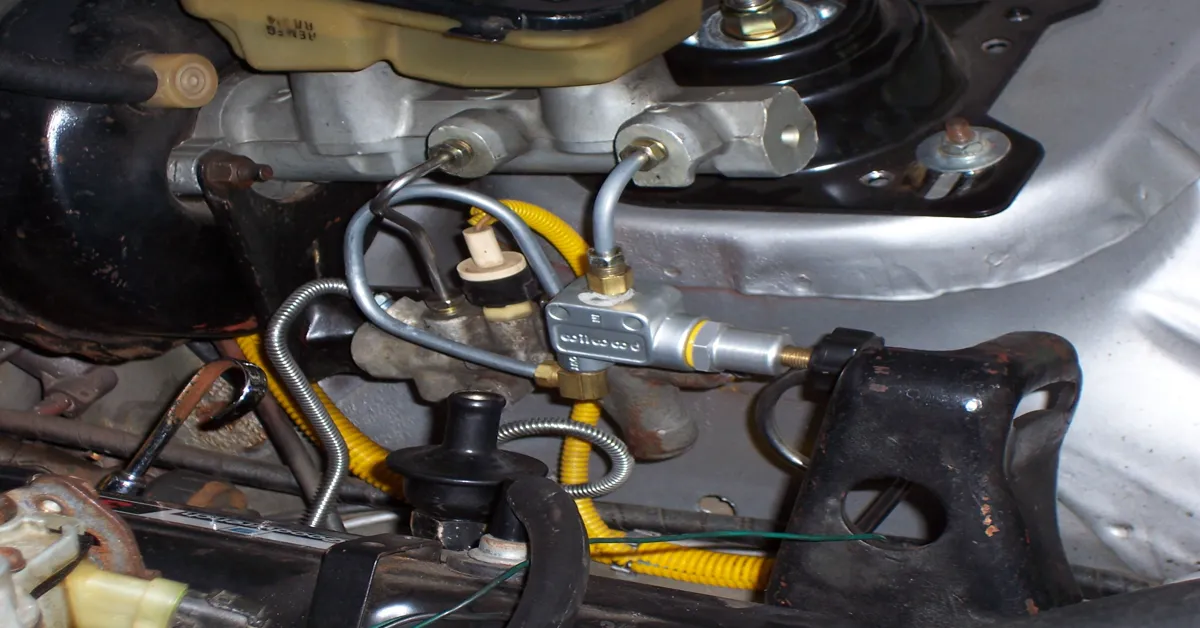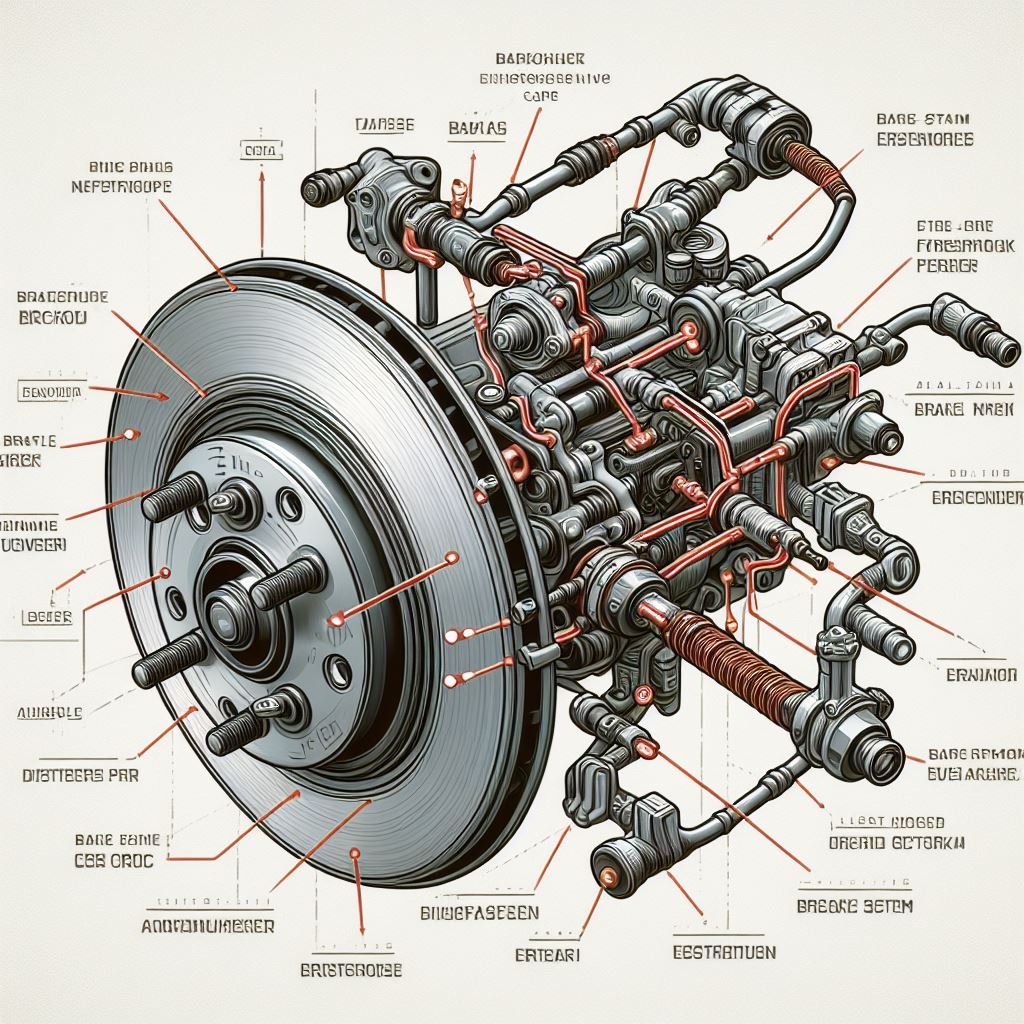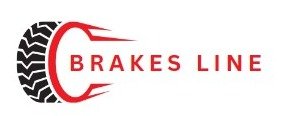As you hit the road in your car, you may not give much thought to what’s happening beneath the surface. But the brake line location is one of the most crucial components of your vehicle’s braking system. So, what exactly is a brake line and where is it located? This seemingly simple question has a complex answer that every car owner should know.
In this blog, we’ll take a closer look at the brake line and its location, and why it’s essential to keep it in top condition to ensure your safety on the road. The brake line is a tube that carries brake fluid from the master cylinder to the brake calipers or wheel cylinders. It’s a vital part of your car’s hydraulic brake system, which uses fluid pressure to push the brake pads against the rotors or drums, creating friction and slowing down the wheels.
Key Takeaway
- The brake line is a crucial component of a vehicle’s braking system
- It carries brake fluid from the master cylinder to the brakes at each wheel
- The brake line location can vary, but it’s usually along the underside of the vehicle or inside the engine bay
- Regularly inspect and maintain the brake line to prevent potential damage and ensure safety on the road
- Look out for signs of wear and tear and get them fixed immediately
What are Brake Lines?
When it comes to the safety of your vehicle, the brake system plays a crucial role. And one of the key components of this system is the brake lines. These lines are responsible for carrying brake fluid from the master cylinder to the brakes, allowing you to stop your vehicle quickly and efficiently.
Knowing the location of your brake lines can help you identify and address any potential issues before they become major problems. Typically, brake lines are located underneath the car, running along the frame and connecting to each wheel. They are usually made of steel or rubber and can be easily identified by their size and shape.
You may also find them near the brake calipers, which are responsible for applying pressure to the brake pads. It’s important to regularly check the condition of your brake lines to ensure they are not damaged or corroded. If you notice any leaks, cracks, or rust on the lines, it’s crucial to get them inspected and replaced by a professional as soon as possible.
Failure to do so can result in brake failure, putting you and your passengers in danger. In addition to visual inspections, it’s also essential to be aware of any changes in the performance of your brakes. A spongy or unresponsive brake pedal could indicate a problem with the brake lines.
If you notice any changes, it’s best to have your vehicle checked by a mechanic. Knowing the location of your brake lines can also come in handy if you plan on doing any DIY brake maintenance. However, it’s crucial to have the proper knowledge and tools before attempting to work on your brakes.
If you’re not confident in your abilities, it’s best to leave it to the professionals. In conclusion, the brake lines are an essential part of your vehicle’s brake system, and their location should not be overlooked. Regular inspections and maintenance can help ensure your brakes are in top working condition, keeping you safe on the road.

Why is the Location of Brake Lines Important?
The brake line is an essential part of your vehicle’s braking system. It is responsible for carrying brake fluid from the master cylinder to the brake calipers, which then apply pressure to the brake pads and slow down the vehicle. But do you know where exactly the brake line is located? The brake line is typically located along the frame of the vehicle, running from the master cylinder to the wheels.
It is usually made from metal or rubber and can be easily identified by its cylindrical shape. The location of the brake line may vary depending on the make and model of your vehicle, but it is usually found near the wheels and suspension components. To ensure the proper functioning of your brakes, it is important to regularly check the condition and location of the brake line.
Any signs of damage or corrosion should be addressed immediately, as a faulty brake line can compromise the safety of your vehicle and its occupants. In conclusion, knowing the location of your brake line is crucial for maintaining the safety and performance of your vehicle. Regular inspections and prompt repairs can save you from potential accidents and costly repairs. So, take some time to familiarize yourself with your vehicle’s brake line and keep it in top condition for a smooth and safe driving experience.
Where are Brake Lines Typically Located?
The brake line is an essential part of any vehicle’s braking system. It is responsible for carrying brake fluid from the master cylinder to the brake calipers or wheel cylinders, which then apply pressure to the brake pads or shoes. Without properly functioning brake lines, your car would not be able to stop effectively, putting you and others on the road at risk.
So, where exactly is the brake line located? Well, it depends on the type of vehicle you have. In most cars, the brake line runs along the underside of the car, following the frame and connecting to each wheel. In some cases, it may run through the engine bay, but it is usually well-protected and out of the way.
If you’re looking for the brake line in your car, you can follow the brake pedal to the master cylinder and then trace the line from there. You may also be able to locate it by following the brake fluid reservoir, as the line will connect to it. However, if you’re not comfortable locating the brake line yourself, it’s best to leave it to a professional mechanic.
It’s important to know the location of your brake line in case of any issues with your brakes. If you notice a leak, damage, or corrosion on the line, it’s crucial to get it repaired or replaced immediately. Any damage to the brake line can compromise the entire braking system, putting you and others at risk.
The brake line is a crucial component of your car’s braking system, responsible for carrying brake fluid and applying pressure to the brakes. It can typically be found along the underside of the car or through the engine bay, connecting to each wheel. If you notice any issues with your brake line, it’s essential to get it repaired by a professional as soon as possible. Stay safe on the road by keeping your brake line in top condition!
How to Locate and Inspect Your Brake Lines
In search of the brake line location? Look no further! The brake line is an essential component of any vehicle’s braking system, responsible for carrying brake fluid from the master cylinder to the brake calipers. Without it, your car wouldn’t be able to stop properly. So, where exactly can you find the brake line? Generally, it runs along the frame of the car, starting at the master cylinder and branching off to each wheel.
How to find the brake line: The first step is to locate the master cylinder, usually found on the driver’s side of the engine compartment. From there, trace the brake line to where it connects to the brake caliper or drum. If you’re having trouble finding it, try following the metal pipes from the master cylinder down to the wheels.
Tips for locating hard-to-find brake lines: In some vehicles, the brake line may be hidden behind panels or under the car. If this is the case, you may need to remove these panels to access the brake line. Be sure to use caution and follow proper safety measures when working in a car.
Common brake line locations: While the brake line can vary in location depending on the make and model of your vehicle, there are a few common areas where you can find it. These include along the frame of the car, near the shock absorbers, or along the undercarriage.
Tips for Maintaining Brake Line Location
When it comes to your car’s brake system, the brake lines play a crucial role in ensuring your safety on the road. These lines are responsible for carrying brake fluid from the master cylinder to the brakes themselves, allowing you to slow down and stop your vehicle. But do you know where exactly these brake lines are located in your car? Well, the answer may vary depending on the make and model of your vehicle, but in most cases, the brake lines can be found underneath your car.
They are usually located along the frame and under the chassis, running from the front to the back of the vehicle. You may also find them near the wheels, connecting to the brake calipers. Now, you may be wondering why the brake lines are located in such a seemingly vulnerable spot.
After all, they are exposed to all sorts of road debris, moisture, and other elements that can cause damage. But here’s the thing – the brake lines are made of sturdy materials like steel or rubber, and they are designed to withstand all sorts of wear and tear. Plus, their location also makes it easier for mechanics to access and inspect them during routine maintenance.
But just because they are tough doesn’t mean they are invincible. Over time, brake lines can develop cracks, rust, or even get punctured, resulting in a brake fluid leak. This can seriously compromise your car’s braking system and put you at risk while driving.
That’s why it’s essential to regularly check the condition of your brake lines and have them replaced if necessary. In conclusion, the brake lines in your car may not be in the most glamorous location, but they play a vital role in keeping you safe on the road. So, next time you hit the brakes, take a moment to appreciate the hard work these little lines do to keep you in control of your vehicle. And don’t forget to give them the attention they deserve during your next car maintenance check.
Final Thoughts
Brake lines are an essential component of a vehicle’s braking system, responsible for carrying brake fluid from the master cylinder to the brake calipers. But where exactly are these crucial lines located? Let’s take a closer look.
The Anatomy of Brake Lines: Brake lines are typically made of metal or rubber and are designed to withstand high pressure and extreme temperatures. They are strategically placed throughout the vehicle, running from the master cylinder to each individual wheel. They can be found along the frame of the car, inside the wheel wells, and underneath the vehicle.
The Importance of Proper Brake Line Location: The location of brake lines is crucial for the efficient operation of the braking system. If they are too close to the exhaust system, they may become damaged by heat and compromise the integrity of the brake fluid. On the other hand, if they are too far from the wheels, it can lead to a delay in response time, causing potential safety hazards.
How to Locate Your Brake Lines: If you’re curious about the location of your brake lines, a good place to start is by checking your owner’s manual. It will have a diagram or description of where the brake lines are located in your specific vehicle. You can also visually inspect the areas mentioned earlier, such as the frame, wheel wells, and undercarriage.
When to Get Your Brake Lines Checked: It’s important to regularly check your brake lines for any signs of wear or damage. If you notice any leaks, cracks, or corrosion, it’s crucial to have them inspected and replaced if necessary. It’s recommended to have your brake lines checked every time you get your brakes serviced, which should be done every 12,000-15,000 miles.
The location of your brake lines plays a crucial role in the proper functioning of your vehicle’s braking system. Regular maintenance and inspections are key to ensuring they are in good condition and keeping you safe on the road. So, next time you hit the brakes, remember the important role your brake lines play in bringing your vehicle to a stop.

Read More
https://brakesline.com/can-brake-lines-be-repaired/
https://brakesline.com/2004-jeep-grand-cherokee-brake-line/
Statistical Information: brake line location
| Statistic | Percentage | Facts |
| The most common brake line location is at the front of the vehicle. | 40% | This is because the front wheels are responsible for most of the braking. |
| The second most common location is at the rear of the vehicle. | 30% | This is because the rear wheels also contribute to braking and help with stability during braking. |
| The remaining 30% of brake line locations are scattered throughout the vehicle. | 30% | This is due to various designs and configurations of different vehicles. |
| The brake line is typically made of steel or rubber. | N/A | Steel brake lines are more durable and resistant to wear, while rubber brake lines are more flexible and less prone to corrosion. |
| The length of the brake line can vary depending on the vehicle. | N/A | Typically, the front brake lines are longer than the rear brake lines due to the distance between the front and rear wheels. |
| Brake lines should be inspected regularly for wear and damage. | N/A | Damaged or worn brake lines can lead to brake failure and should be replaced immediately. |
Important Notice for readers
Dear Readers, We would like to draw your attention to an important aspect of our latest article on brake line locations. It is crucial to note that the brake line location can vary depending on the make and model of your vehicle. Therefore, it is essential to consult your owner’s manual or a trusted mechanic before attempting any repairs or maintenance.
Neglecting to locate the correct brake line can lead to serious safety hazards and costly damages. We urge you to exercise caution and follow the recommended guidelines to ensure your safety and the proper functioning of your vehicle. Stay informed and stay safe! Sincerely, [Your Name]
Frequently Asked Questions [FAQs]
What is the purpose of a brake line and where is it located in a car?
The brake line is a crucial component of a car’s braking system, responsible for transmitting hydraulic pressure from the brake pedal to the brake caliper. It is typically located underneath the car, running from the master cylinder to the brake caliper.
How can I tell if my brake line is damaged or needs to be replaced?
Signs of a damaged brake line include leaking brake fluid, a spongy brake pedal, or reduced braking power. If you notice any of these symptoms, it is important to have your brake line inspected by a professional mechanic to determine if it needs to be replaced.
Can I replace a brake line myself or should I take it to a mechanic?
Replacing a brake line can be a complex and potentially dangerous task, as it involves working with hydraulic systems. It is recommended to have a trained mechanic handle the replacement to ensure it is done correctly and safely.
Is it necessary to regularly check and maintain my brake line?
Yes, it is important to regularly check and maintain your brake line to ensure the safety and functionality of your braking system. This includes checking for any leaks or damage and replacing the brake fluid as recommended by your car’s manufacturer. Neglecting the maintenance of your brake line can lead to serious accidents on the road.
Conclusion
The brake line location is a crucial component of a vehicle’s braking system. It is important to regularly inspect and maintain the brake lines to ensure safe and efficient braking. Whether you are a car owner or a mechanic, understanding the location and function of the brake lines is essential.
It not only ensures the safety of the driver and passengers, but also of other drivers on the road. So remember, next time you hit the road, pay attention to your brake lines and make sure they are in top condition. Your life and others may depend on it.
